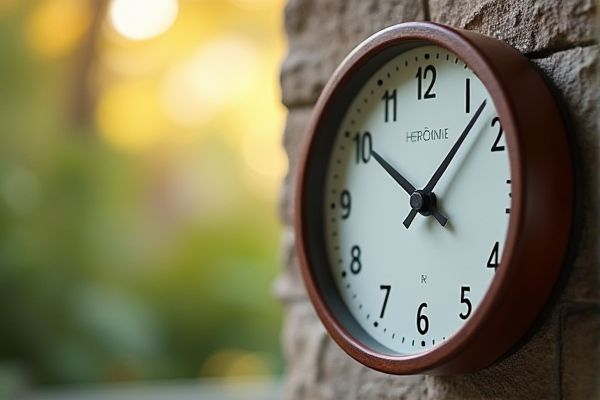
Outdoor clocks provide accurate timekeeping with weather-resistant designs ideal for garden or patio use, while indoor-outdoor thermometers measure temperature simultaneously inside and outside, offering valuable climate data for your home. Discover the unique benefits of each device to choose the perfect addition for your living space by exploring the rest of this article.
Table of Comparison
| Feature | Outdoor Clock | Indoor-Outdoor Thermometer |
|---|---|---|
| Primary Function | Displays current time outside | Measures temperature both indoors and outdoors |
| Measurement Type | Time (hours, minutes) | Temperature (degC or degF) |
| Display Location | Outdoor areas like gardens, patios | Both indoor and outdoor spaces |
| Weather Resistance | Waterproof, UV resistant | Durable sensor for outdoor temperatures |
| Power Source | Batteries or solar | Usually batteries, some with wireless sensors |
| Additional Features | May include date, temperature (some models) | Humidity monitoring, weather forecast, wireless connectivity |
Understanding Outdoor Clocks: Features and Functions
Outdoor clocks are designed to withstand various weather conditions with durable, weather-resistant materials ensuring accurate time display in open environments. Many models include additional features like temperature and humidity sensors, enabling users to monitor outdoor climate seamlessly. These multifunctional devices combine timekeeping with environmental data, offering practical insights for gardening, outdoor activities, and daily planning.
What Is an Indoor-Outdoor Thermometer?
An indoor-outdoor thermometer measures temperature both inside and outside your home, providing real-time data for accurate climate monitoring. Unlike outdoor clocks that primarily display time, this device offers dual readings through separate sensors, helping you track temperature fluctuations effortlessly. Your ability to adjust heating or cooling systems improves with precise indoor-outdoor temperature data.
Key Differences: Timekeeping vs. Temperature Monitoring
Outdoor clocks focus on accurate timekeeping with weather-resistant designs ideal for gardens and patios, ensuring clear visibility in various lighting conditions. Indoor-outdoor thermometers prioritize precise temperature monitoring for both indoor and outdoor environments, providing real-time data to help you manage comfort and safety. Your choice depends on whether tracking time or monitoring temperature is more critical for your space.
Installation Requirements: Clocks vs. Thermometers
Outdoor clocks typically require secure mounting on walls or posts with weather-resistant features to withstand environmental conditions, while indoor-outdoor thermometers often need minimal installation, such as placing sensors outside and displays inside with simple mounting options. Thermometers may also require a power source or battery for electronic readings, whereas traditional clocks might run on batteries without external wiring. Understanding these installation differences helps ensure your outdoor equipment functions accurately and remains durable in varying weather.
Durability and Weather Resistance
Outdoor clocks are specifically designed with robust materials like stainless steel and weather-resistant coatings to withstand extreme temperatures, rain, and UV exposure, ensuring long-lasting durability. Indoor-outdoor thermometers feature sealed sensors and waterproof casings that protect sensitive electronic components from humidity and temperature fluctuations, maintaining accurate readings in diverse weather conditions. Both devices prioritize weather resistance, but outdoor clocks often incorporate heavier-duty construction for prolonged outdoor exposure, while indoor-outdoor thermometers balance durability with precision sensor protection.
Display and Readability Comparison
Outdoor clocks often feature large, weather-resistant faces with high-contrast numbers designed for easy readability from a distance in various lighting conditions. Indoor-outdoor thermometers typically include digital or analog displays that present precise temperature readings but may be smaller and less visible outdoors. Your choice depends on whether you prioritize quick time checks or detailed environmental data visibility.
Power Sources: Battery, Solar, or Wired?
Outdoor clocks often rely on battery power for easy installation and maintenance-free operation, while some models feature solar panels to harness renewable energy and reduce battery changes. Indoor-outdoor thermometers typically offer flexibility with wired power options for continuous use or battery operation for portability and convenience. Choosing between battery, solar, or wired power sources depends on your installation location, desired maintenance frequency, and energy preferences.
Ideal Locations for Each Device
Outdoor clocks are best suited for patios, gardens, or decks where timekeeping is essential for activities and gatherings, while indoor-outdoor thermometers excel when placed near windows or entrances to provide accurate temperature readings inside and outside your home. Positioning an outdoor clock in a visible, weather-protected spot ensures durability and easy time reference, whereas the thermometer requires exposure to outdoor air yet protection from direct sunlight and precipitation for precise measurements. Your choice depends on whether you prioritize time tracking in outdoor living spaces or constant temperature monitoring across indoor and outdoor environments.
Maintenance and Longevity
Outdoor clocks typically require regular maintenance to prevent damage from weather elements such as rain and extreme temperatures, ensuring their longevity with periodic cleaning and battery changes. Indoor-outdoor thermometers often feature weather-resistant casings and fewer moving parts, which can reduce upkeep while maintaining accurate temperature readings over time. Choosing the right device for your needs will help optimize durability and minimize maintenance efforts.
Choosing the Right Device for Your Needs
Selecting between an outdoor clock and an indoor-outdoor thermometer depends on your primary need for timekeeping versus temperature monitoring. Outdoor clocks provide clear, weather-resistant time display suitable for gardens or patios, while indoor-outdoor thermometers offer precise temperature readings that help you regulate your home's comfort and plan outdoor activities. Your choice should reflect whether you prioritize knowing the exact time outdoors or tracking temperature variations both inside and outside your living space.
 homyna.com
homyna.com